Excerpts from Jim Conrad's
Naturalist Newsletter
entry dated May 5, 2022, issued from near Tequisquiapan, elevation about 1,900m (6200 ft), ~N20.57°, ~ W99.89°, Querétaro state, MÉXICO
BESS BEETLES, WEB TUBES & FRASS
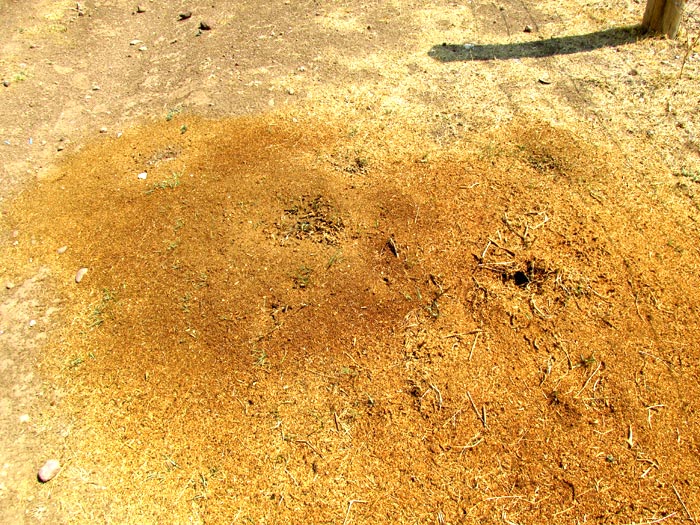
The mystery began with what's shown above. It's an active harvester-ant nest, like the dozens of such nests one passes by while wandering any trail or walking along any road with bare sides in this arid, scrubby region. You may enjoy browsing our Harvester Ant page. About 500 species of harvester ants are documented, with the species scattered among various genera. As such, there's enormous variety in individual species behavior, and nest appearance. The above nest is surrounded by a carpet of crumbly organic material, which is unusual in this area because normally such nests are surrounded by an open space strewn with small pebbles excavated from the subterranean ant chambers. However, with so many species, differences like this are to be expected. What's not to be expected is shown below in a close-up of the dark patch appearing a little above and to the left of the above image's center:
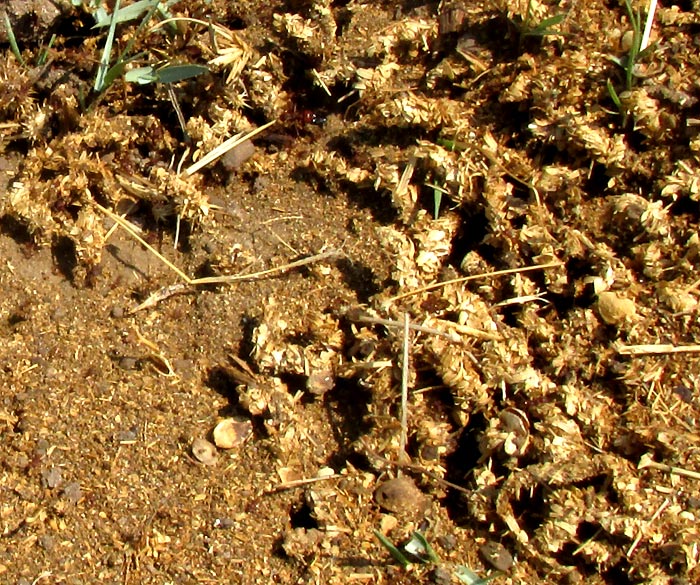
The dark patch consists of hundreds of wormlike items covered with crumbly organic matter, emerging from more organic matter. Below, on the left, you see one of the wormlike items, and on the left, the same item appears with most of its organic matter scraped off. Revealed is a collapsed tube composed of tightly matted silken fibers:
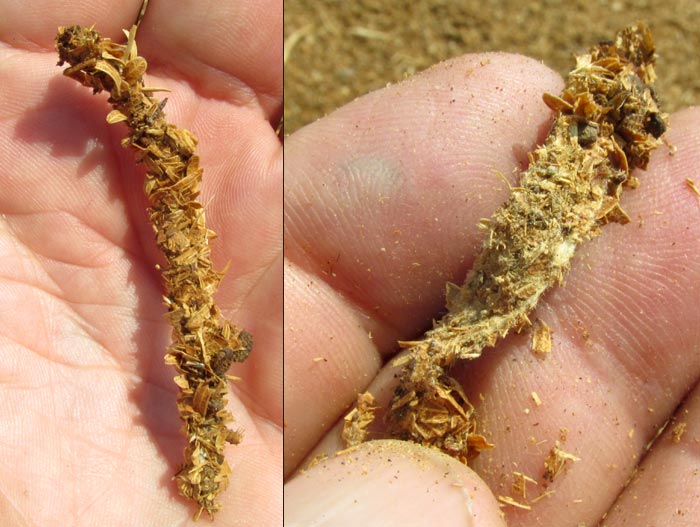
This reminds one of the silken cocoons covering bagworm caterpillars before they metamorphose into winged adult moths. Normally, bagworm bags bear dried-out parts of the herbage they feed on.
But, how does all this hang together? Does this harvester ant species at some point in its life cycle produce silken tubes? Or is there another insect, a silken-tube producing one, living in the ant nest, perhaps in a mutualistic relationship?
During the next few following days, among the dozens of harvester nests checked, none turned up covered with organic matter and none had organic-matter-covered silken tubes. However, finally a much larger community of such silken tubes turned up, this time among tall clumps of late-dry-season, parched grass, shown below:
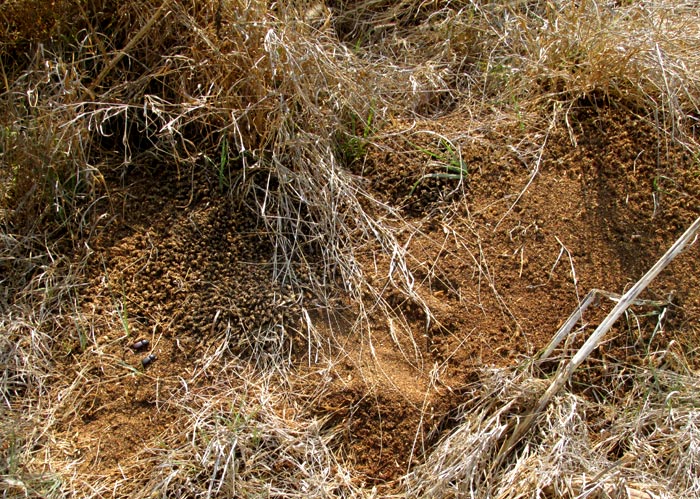
Here I saw no indication of a harvester ant nest. A few harvester ants were wandering around, but these days they're everywhere. What I did find, though, is shown below:
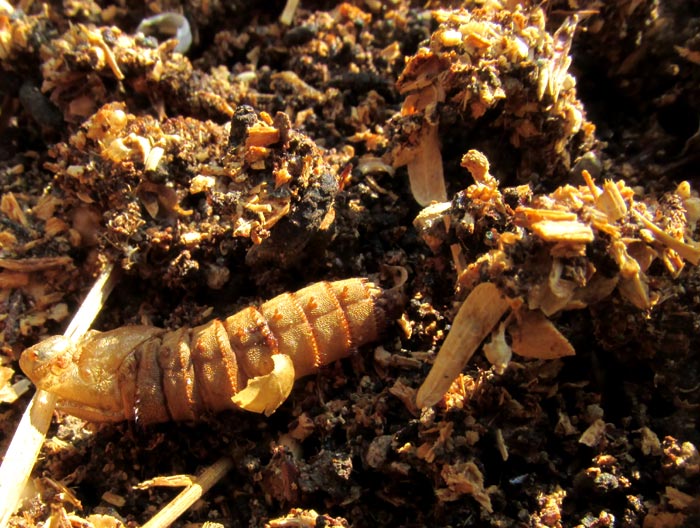
At the right in the above picture is a tube, seemingly with its end open, amid a field of many such tubes. On the left, the pale thing is the exoskeleton of an insect larva. The impression is that an insect larva emerged from the tube, the larva exoskeleton split open and the mature insect went away. Here's a close-up of the exoskeleton:
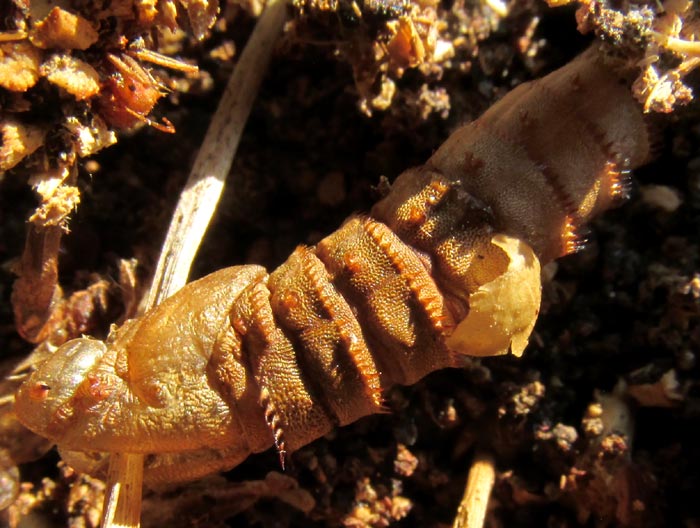
In that picture, at the left, the discarded exoskeleton's split to release the adult is conveniently is highlighted by a straw passing through the split. Several such exoskeletons were found in the 3-meter across (10ft) area of organic debris with tubes. Also, several dead beetles were found in the same area:
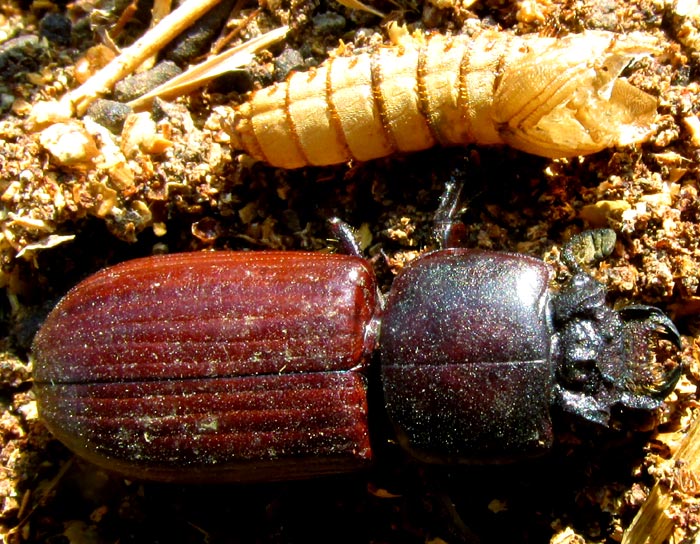
It's uncertain whether the larva exoskeleton was produced by this kind of beetle, and I'm uncertain what kind of beetle it is. My best bet is that it's one of the 500 or so species of bess beetles, family Passalidae, very closely related to the Scarab and Stag Beetle Families. Bess beetles occur worldwide but mainly in the tropics. And they're described as typically living inside rotting logs in forests, where adults and larvae feed on wood. Eggs are usually placed in a "nest" of frass. Frass is excrement from the digestive systems of various insects. Both the adults and larvae of bess beetles are known to feed on feces that's been predigested by microflora.
Moreover, a 2009 paper by Larry Jiménez-Ferbans and Germán Amat-García, entitled "Sinopsis de los Passalidae (Coleoptera: Scarabaeoidae) del Caribe Colombiano," mentions that some bess beetles, of the genus Ptichopus, occupy the detritus of leafcutter ants. On the Internet, if you look for pictures of Ptichopus angulatus, a species known to occur in Mexico, it bears a fair semblance to ours.
All this suggests a story, which is purely conjectural and not proven at all:
The story is that here we have a species of bess beetle which nests where there's plenty of organic matter and, at least sometimes, ant excrement. In this area's thin-soiled, overgrazed scrub environment, one place to find concentrated accumulations of organic matter -- conditions somewhat similar to the rotting logs most bess beetles occupy -- as well as microflora-predigested ant excrement, if that's one's need, is in the seed banks of harvester ant nests. Periodically the bess beetle larvae produce web tubes in which they migrate to the surface, where the larvae metamorphose into winged bess beetles.
One problem with that story is that on the Internet I find no mention of any kind of beetle larvae producing silken tubes, and that's a big problem. However, we're in the understudied tropics here, so maybe we have something not documented.
Whatever the case, with this page now online, whenever any researcher does an Internet search on keywords such as "passalidae silken tubes ant nests," this page will be there with its documentation.